Characteristics of women with cesarean section due to placenta previa at national hospital of obstetric and gynecology in 2020
Objective: Describe the clinical,
subclinical, and resuscitation care after
placenta previa operations at the National
Hospital For Obstetric And Gynecology.
Method: Descriptive study design was
used to recruited 149 women who had a
cesarean section due to placenta previa at
the department of resuscitation anesthesia
in the National Hospital For Obstetric And
Gynecology from January to September
2020.Results: The average age of pregnant
women was 32.5 ± 4.9 years old, mainly in
the 22 to 35 years old group (71.1%); 23.5%
of them had comorbidities; 40.9% get
pregnant up to 3 times; 61.7% of them had
ever a C-section. In the pregnancy, 42.8%
of the women had preterm birth and 4.1%
of them were pregnant with twins. While
admitted to the hospital, 49% of women
presented with vaginal bleeding and 34.9%
of them were anemia; 57% of women had
uterine contractions and most of them
presented with an open cervix. Almost of
participants had completed placenta previa
(85.2%) and 34.9% of them had Placenta
Accreta. 63.1% of women had a cesarean
section and preserved the uterus and 36.9%
of them undergo surgery of hysterectomy.
43.6% of the women experienced servere
bleeding and half of them had to have a
blood transfusion, the average amount of
transfusion was 3.11 ± 2.6 units of blood.
After surgery, 55% of pregnant women
recovered well. Conclusion: Most of the
women had better progress after surgery
in terms of mental status, breathing,
circulation, pain sensation. Health care staff
should provide post-cesarean care for the
woman with history of cesarean section due
to placenta previa, pregnancy with comorbid
diseases, placenta accreta, emergency
surgery and women with servere bleeding
pre-and post- surgery.
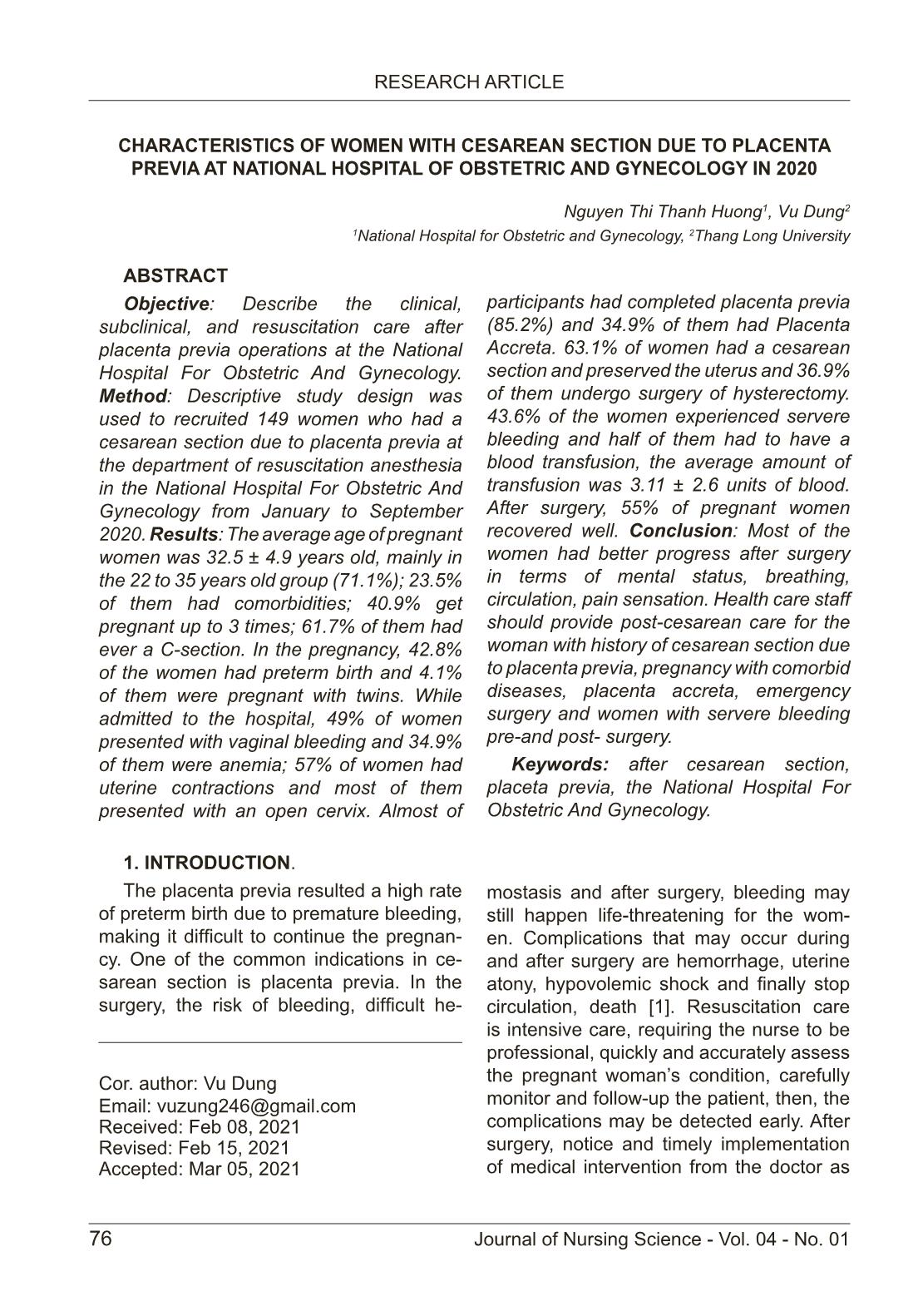
Trang 1
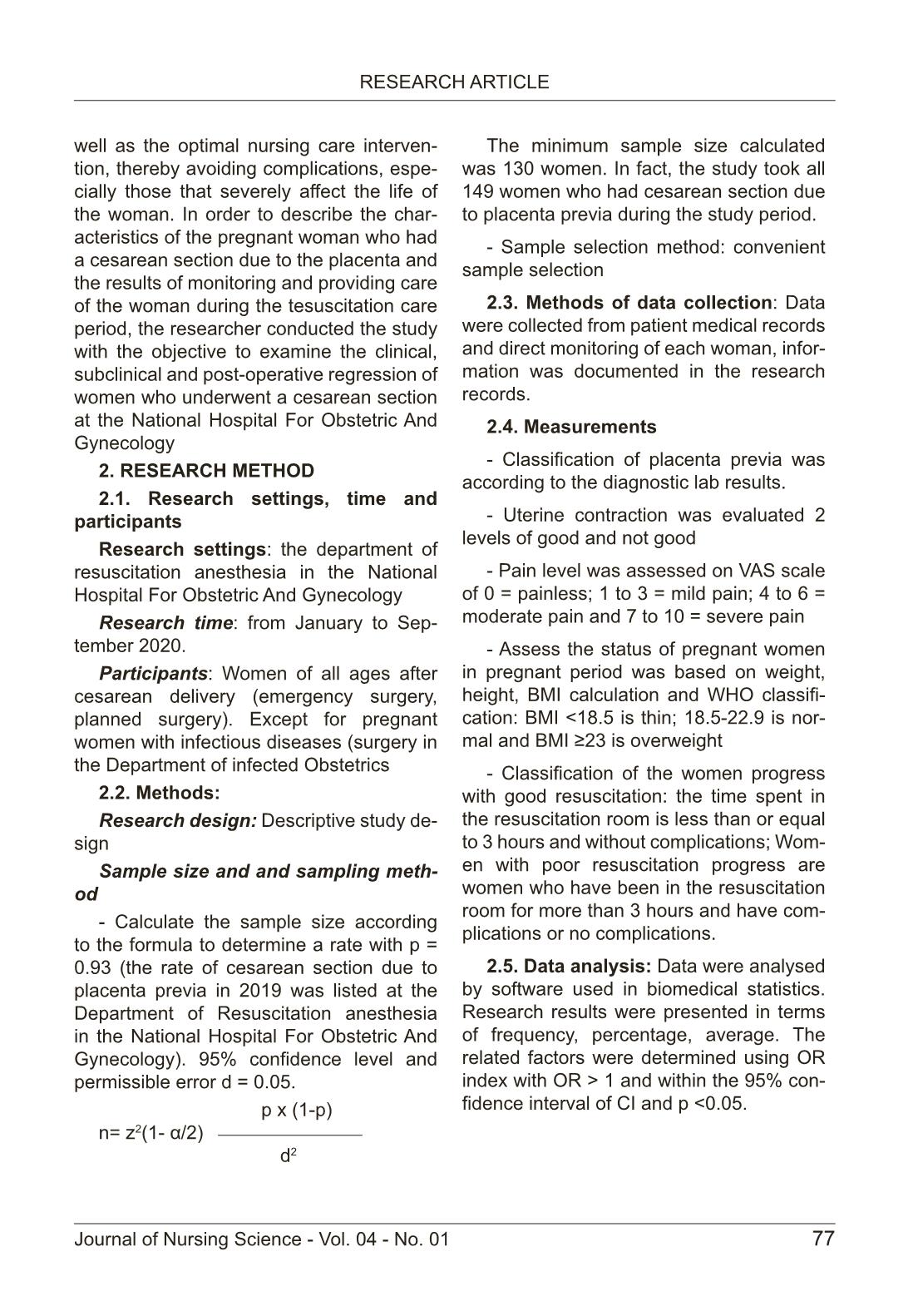
Trang 2
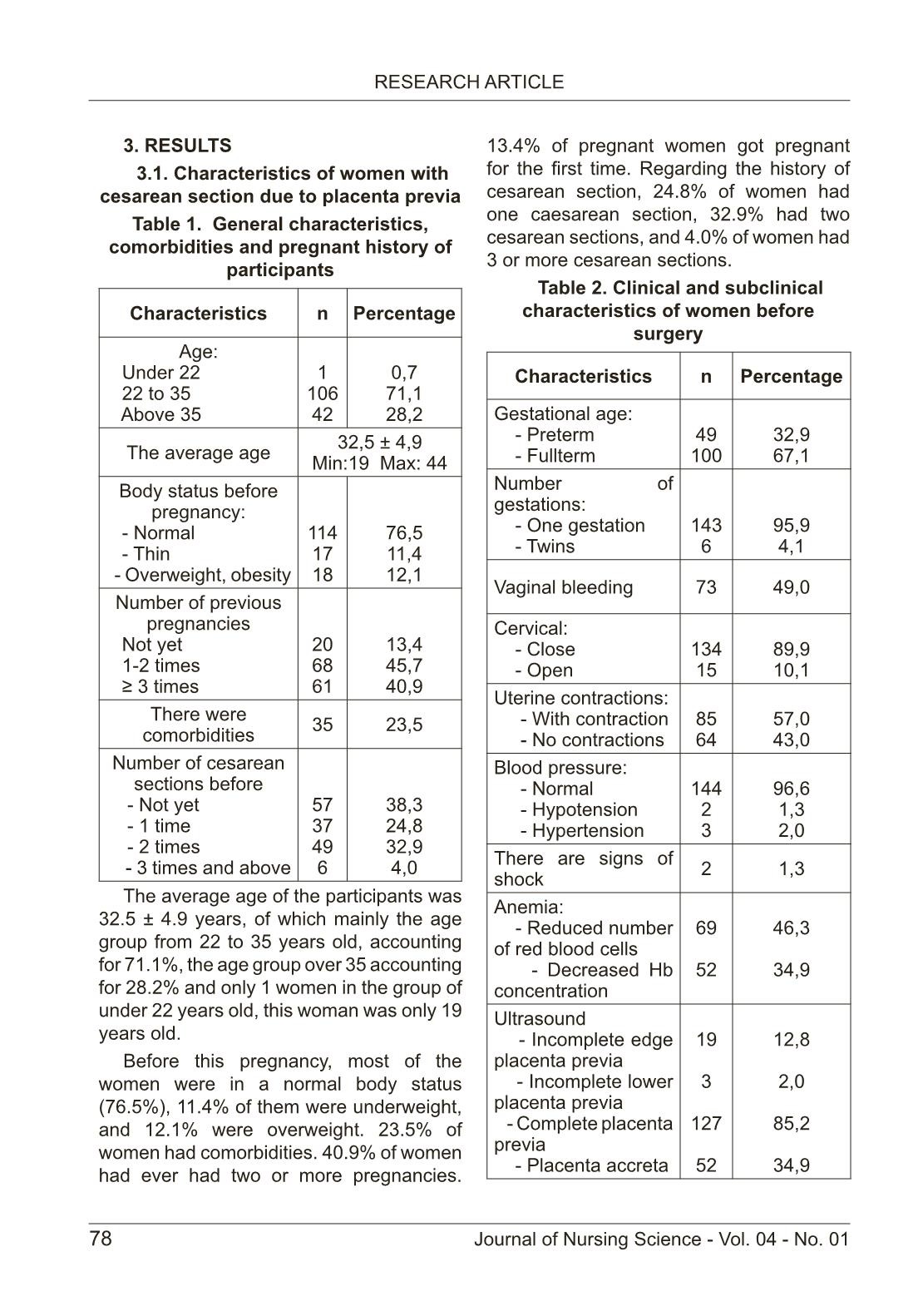
Trang 3
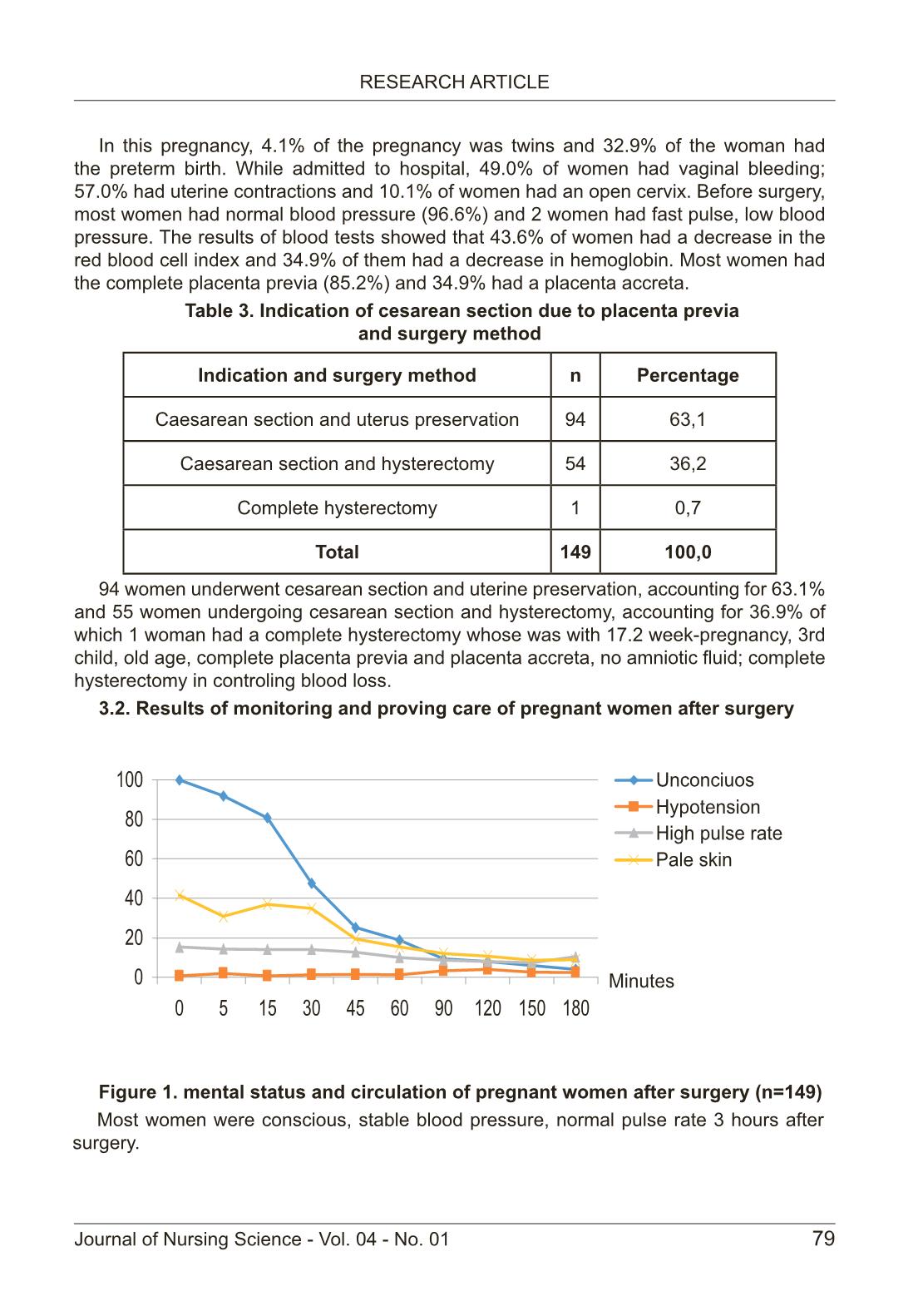
Trang 4
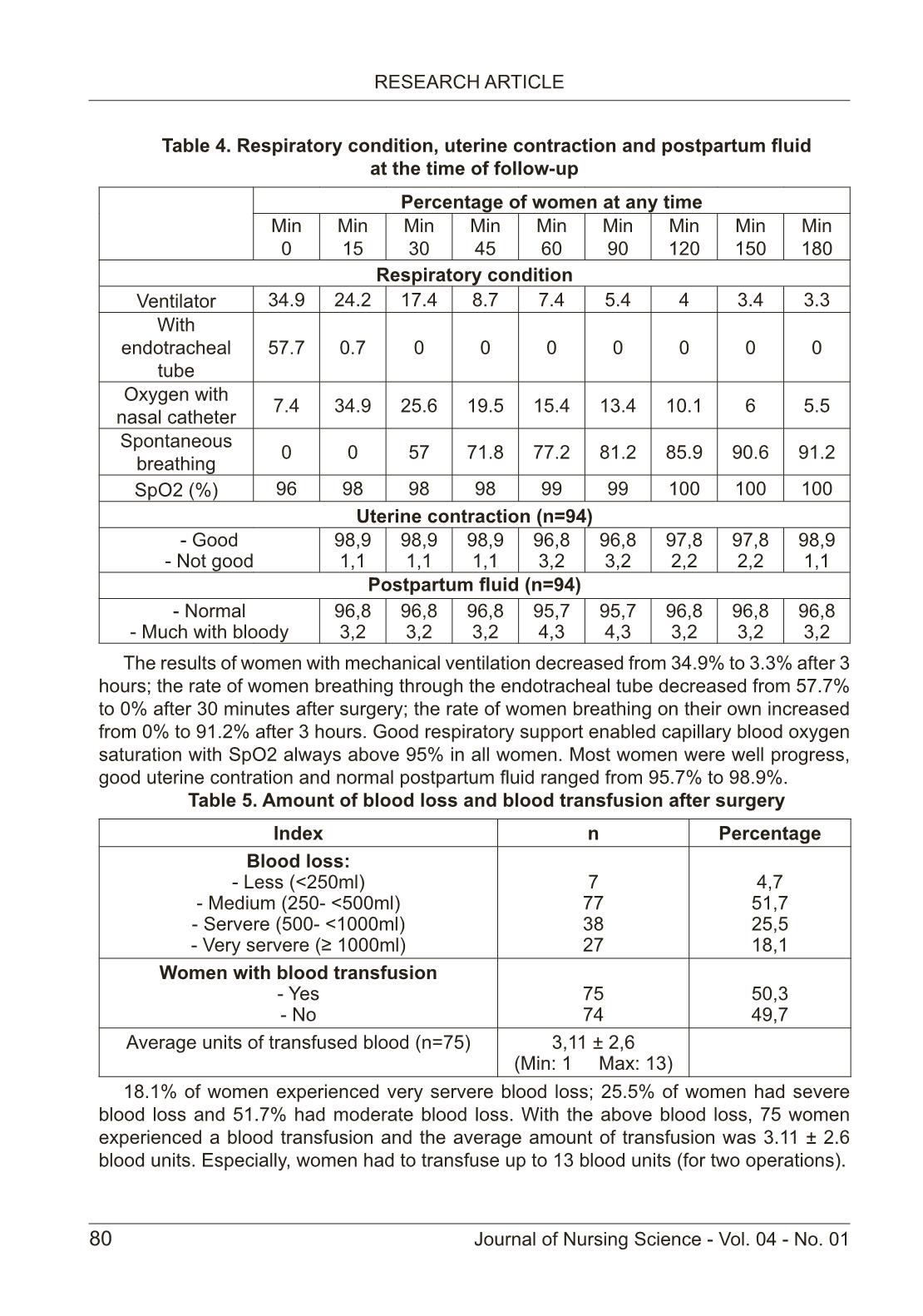
Trang 5
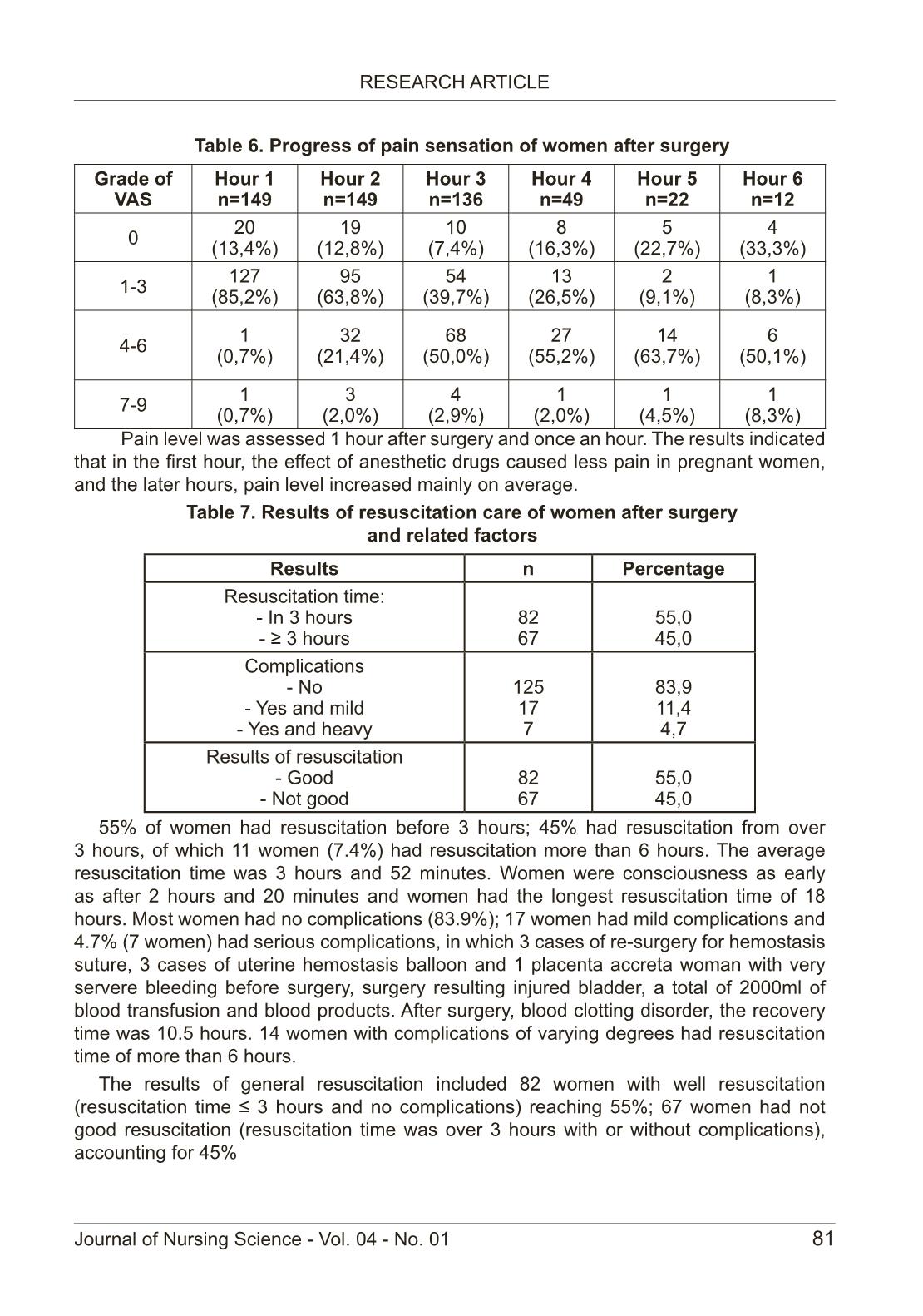
Trang 6
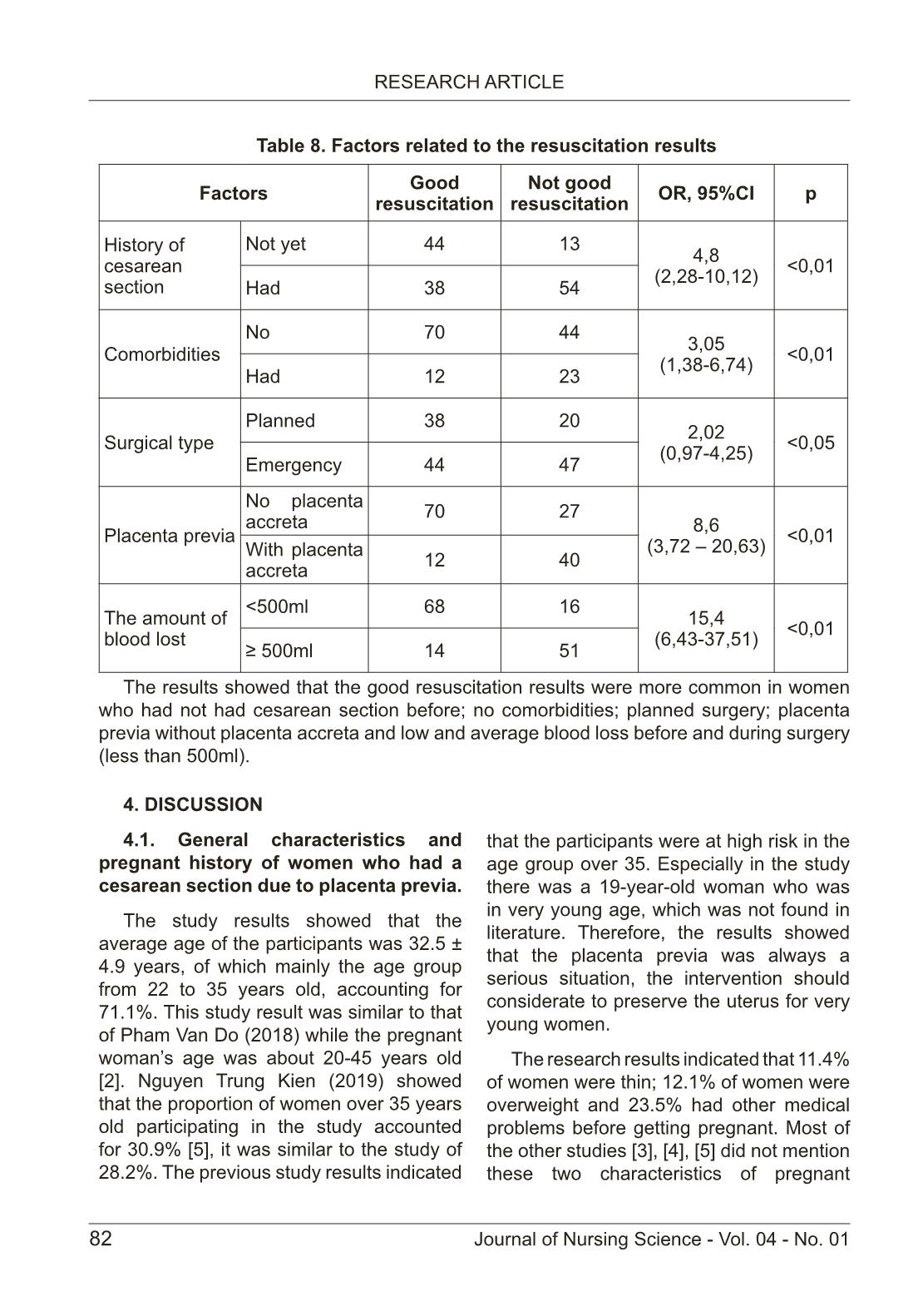
Trang 7
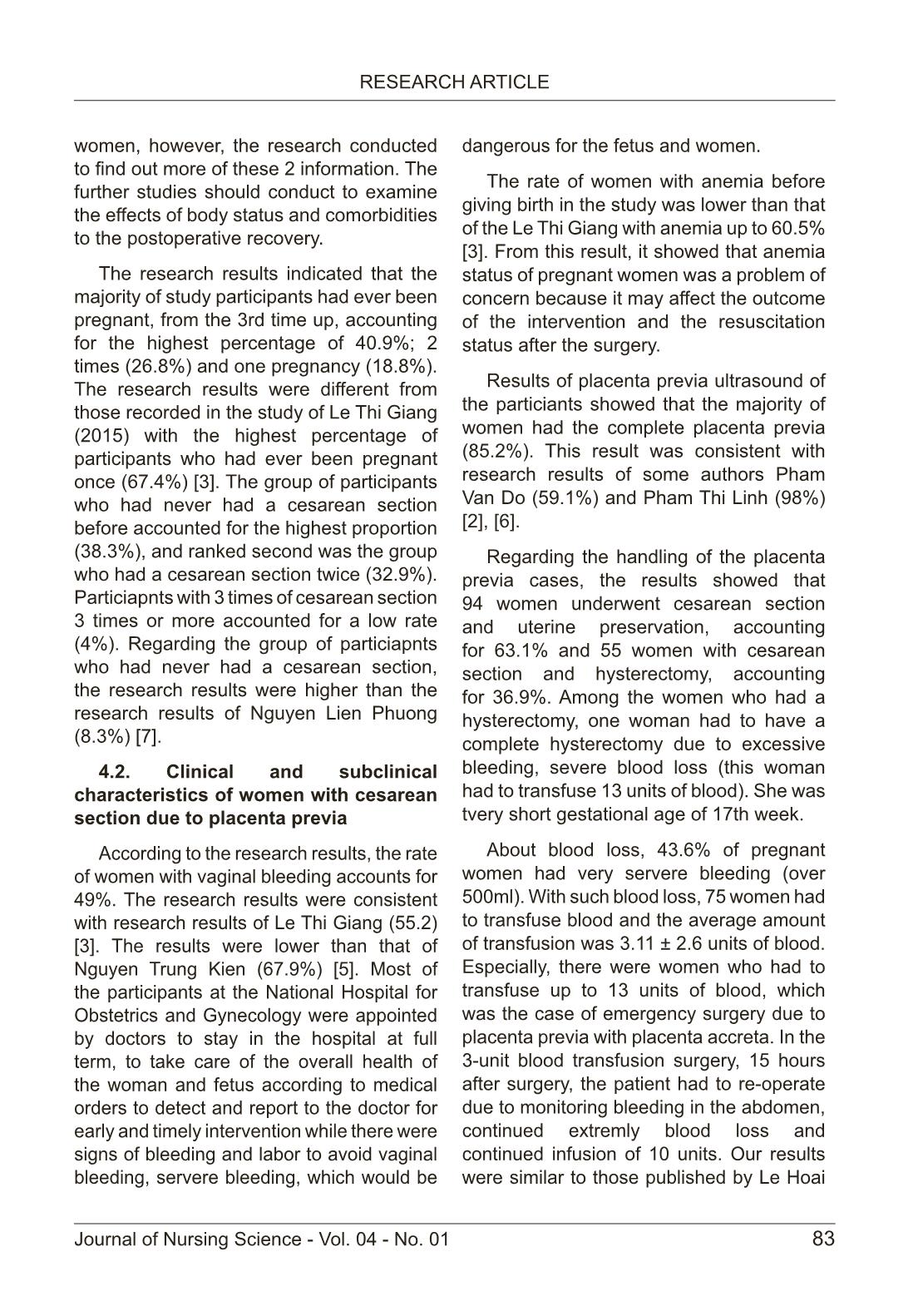
Trang 8
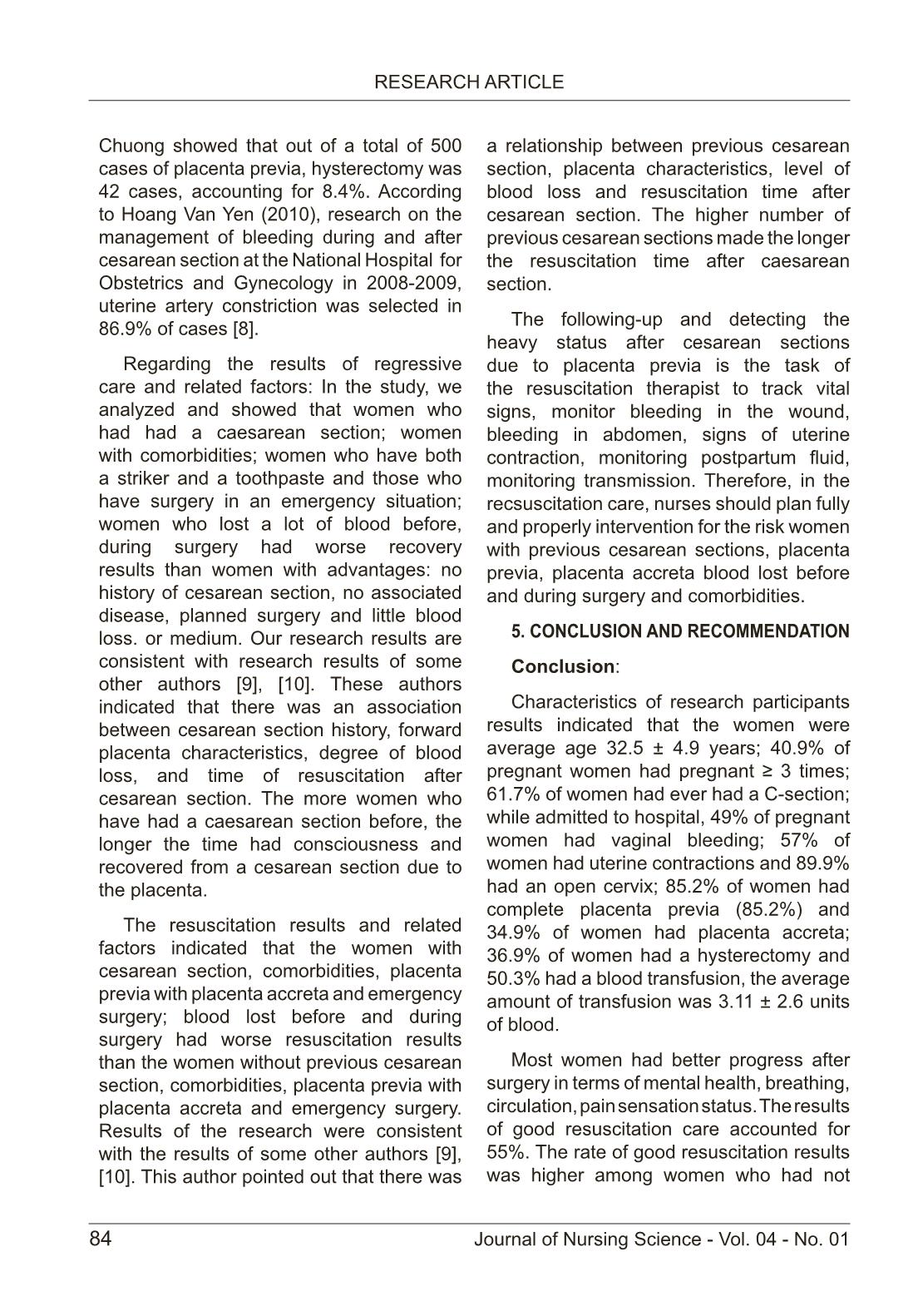
Trang 9
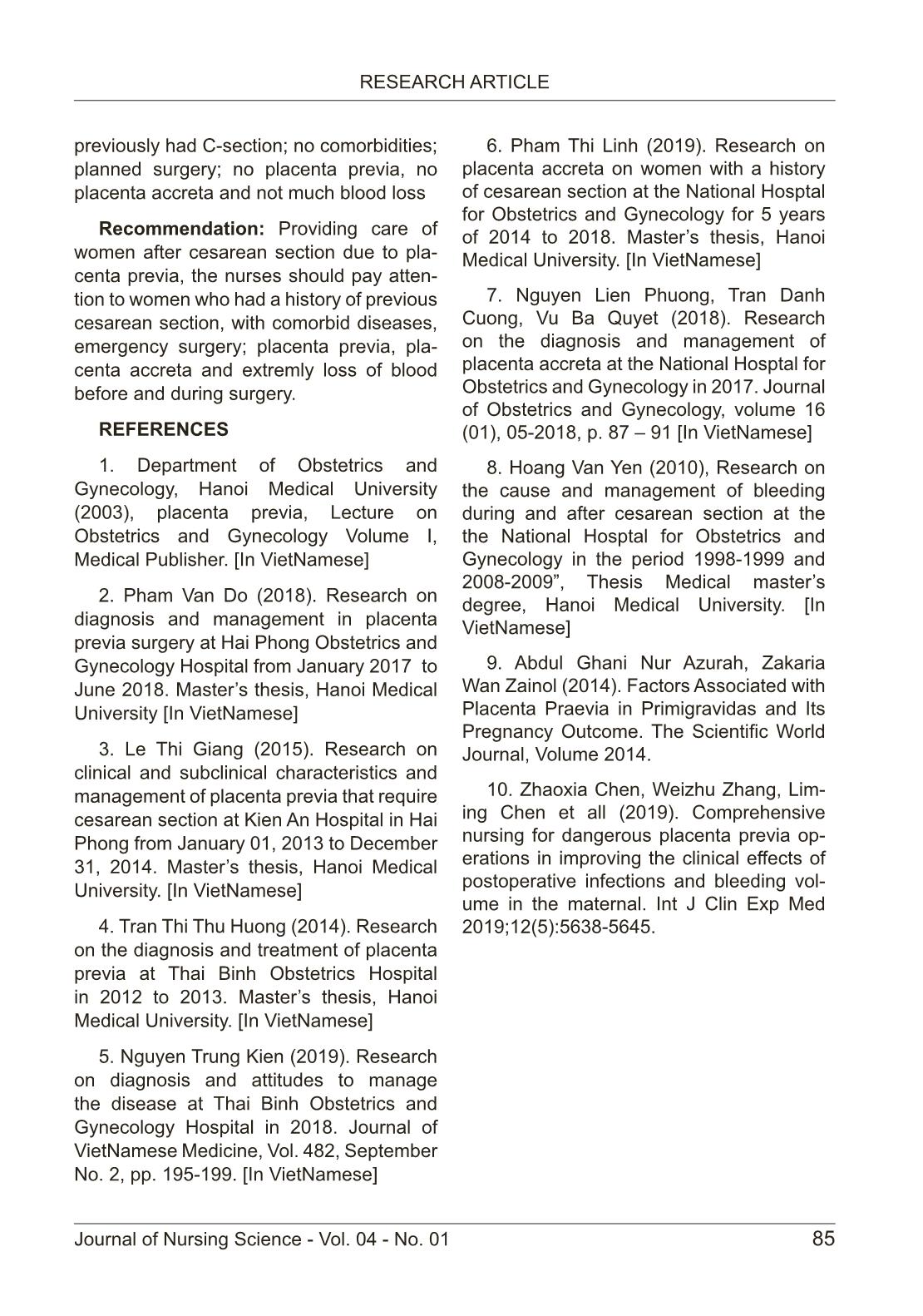
Trang 10
Tóm tắt nội dung tài liệu: Characteristics of women with cesarean section due to placenta previa at national hospital of obstetric and gynecology in 2020
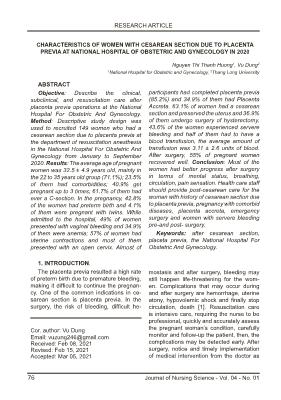
76 RESEARCH ARTICLE Journal of Nursing Science - Vol. 04 - No. 01 CHARACTERISTICS OF WOMEN WITH CESAREAN SECTION DUE TO PLACENTA PREVIA AT NATIONAL HOSPITAL OF OBSTETRIC AND GYNECOLOGY IN 2020 Nguyen Thi Thanh Huong1, Vu Dung2 1National Hospital for Obstetric and Gynecology, 2Thang Long University ABSTRACT Objective: Describe the clinical, subclinical, and resuscitation care after placenta previa operations at the National Hospital For Obstetric And Gynecology. Method: Descriptive study design was used to recruited 149 women who had a cesarean section due to placenta previa at the department of resuscitation anesthesia in the National Hospital For Obstetric And Gynecology from January to September 2020. Results: The average age of pregnant women was 32.5 ± 4.9 years old, mainly in the 22 to 35 years old group (71.1%); 23.5% of them had comorbidities; 40.9% get pregnant up to 3 times; 61.7% of them had ever a C-section. In the pregnancy, 42.8% of the women had preterm birth and 4.1% of them were pregnant with twins. While admitted to the hospital, 49% of women presented with vaginal bleeding and 34.9% of them were anemia; 57% of women had uterine contractions and most of them presented with an open cervix. Almost of participants had completed placenta previa (85.2%) and 34.9% of them had Placenta Accreta. 63.1% of women had a cesarean section and preserved the uterus and 36.9% of them undergo surgery of hysterectomy. 43.6% of the women experienced servere bleeding and half of them had to have a blood transfusion, the average amount of transfusion was 3.11 ± 2.6 units of blood. After surgery, 55% of pregnant women recovered well. Conclusion: Most of the women had better progress after surgery in terms of mental status, breathing, circulation, pain sensation. Health care staff should provide post-cesarean care for the woman with history of cesarean section due to placenta previa, pregnancy with comorbid diseases, placenta accreta, emergency surgery and women with servere bleeding pre-and post- surgery. Keywords: after cesarean section, placeta previa, the National Hospital For Obstetric And Gynecology. 1. INTRODUCTION. The placenta previa resulted a high rate of preterm birth due to premature bleeding, making it difficult to continue the pregnan- cy. One of the common indications in ce- sarean section is placenta previa. In the surgery, the risk of bleeding, difficult he- mostasis and after surgery, bleeding may still happen life-threatening for the wom- en. Complications that may occur during and after surgery are hemorrhage, uterine atony, hypovolemic shock and finally stop circulation, death [1]. Resuscitation care is intensive care, requiring the nurse to be professional, quickly and accurately assess the pregnant woman’s condition, carefully monitor and follow-up the patient, then, the complications may be detected early. After surgery, notice and timely implementation of medical intervention from the doctor as Cor. author: Vu Dung Email: vuzung246@gmail.com Received: Feb 08, 2021 Revised: Feb 15, 2021 Accepted: Mar 05, 2021 77 RESEARCH ARTICLE Journal of Nursing Science - Vol. 04 - No. 01 well as the optimal nursing care interven- tion, thereby avoiding complications, espe- cially those that severely affect the life of the woman. In order to describe the char- acteristics of the pregnant woman who had a cesarean section due to the placenta and the results of monitoring and providing care of the woman during the tesuscitation care period, the researcher conducted the study with the objective to examine the clinical, subclinical and post-operative regression of women who underwent a cesarean section at the National Hospital For Obstetric And Gynecology 2. RESEARCH METHOD 2.1. Research settings, time and participants Research settings: the department of resuscitation anesthesia in the National Hospital For Obstetric And Gynecology Research time: from January to Sep- tember 2020. Participants: Women of all ages after cesarean delivery (emergency surgery, planned surgery). Except for pregnant women with infectious diseases (surgery in the Department of infected Obstetrics 2.2. Methods: Research design: Descriptive study de- sign Sample size and and sampling meth- od - Calculate the sample size according to the formula to determine a rate with p = 0.93 (the rate of cesarean section due to placenta previa in 2019 was listed at the Department of Resuscitation anesthesia in the National Hospital For Obstetric And Gynecology). 95% confidence level and permissible error d = 0.05. p x (1-p) n= z2(1- α/2) d2 The minimum sample size calculated was 130 women. In fact, the study took all 149 women who had cesarean section due to placenta previa during the study period. - Sample selection method: conven ... 5 women experienced a blood transfusion and the average amount of transfusion was 3.11 ± 2.6 blood units. Especially, women had to transfuse up to 13 blood units (for two operations). 81 RESEARCH ARTICLE Journal of Nursing Science - Vol. 04 - No. 01 Table 6. Progress of pain sensation of women after surgery Grade of VAS Hour 1 n=149 Hour 2 n=149 Hour 3 n=136 Hour 4 n=49 Hour 5 n=22 Hour 6 n=12 0 20(13,4%) 19 (12,8%) 10 (7,4%) 8 (16,3%) 5 (22,7%) 4 (33,3%) 1-3 127(85,2%) 95 (63,8%) 54 (39,7%) 13 (26,5%) 2 (9,1%) 1 (8,3%) 4-6 1(0,7%) 32 (21,4%) 68 (50,0%) 27 (55,2%) 14 (63,7%) 6 (50,1%) 7-9 1(0,7%) 3 (2,0%) 4 (2,9%) 1 (2,0%) 1 (4,5%) 1 (8,3%) Pain level was assessed 1 hour after surgery and once an hour. The results indicated that in the first hour, the effect of anesthetic drugs caused less pain in pregnant women, and the later hours, pain level increased mainly on average. Table 7. Results of resuscitation care of women after surgery and related factors Results n Percentage Resuscitation time: - In 3 hours - ≥ 3 hours 82 67 55,0 45,0 Complications - No - Yes and mild - Yes and heavy 125 17 7 83,9 11,4 4,7 Results of resuscitation - Good - Not good 82 67 55,0 45,0 55% of women had resuscitation before 3 hours; 45% had resuscitation from over 3 hours, of which 11 women (7.4%) had resuscitation more than 6 hours. The average resuscitation time was 3 hours and 52 minutes. Women were consciousness as early as after 2 hours and 20 minutes and women had the longest resuscitation time of 18 hours. Most women had no complications (83.9%); 17 women had mild complications and 4.7% (7 women) had serious complications, in which 3 cases of re-surgery for hemostasis suture, 3 cases of uterine hemostasis balloon and 1 placenta accreta woman with very servere bleeding before surgery, surgery resulting injured bladder, a total of 2000ml of blood transfusion and blood products. After surgery, blood clotting disorder, the recovery time was 10.5 hours. 14 women with complications of varying degrees had resuscitation time of more than 6 hours. The results of general resuscitation included 82 women with well resuscitation (resuscitation time ≤ 3 hours and no complications) reaching 55%; 67 women had not good resuscitation (resuscitation time was over 3 hours with or without complications), accounting for 45% 82 RESEARCH ARTICLE Journal of Nursing Science - Vol. 04 - No. 01 Table 8. Factors related to the resuscitation results Factors Good resuscitation Not good resuscitation OR, 95%CI p History of cesarean section Not yet 44 13 4,8 (2,28-10,12) <0,01Had 38 54 Comorbidities No 70 44 3,05 (1,38-6,74) <0,01Had 12 23 Surgical type Planned 38 20 2,02 (0,97-4,25) <0,05Emergency 44 47 Placenta previa No placenta accreta 70 27 8,6 (3,72 – 20,63) <0,01With placenta accreta 12 40 The amount of blood lost <500ml 68 16 15,4 (6,43-37,51) <0,01≥ 500ml 14 51 The results showed that the good resuscitation results were more common in women who had not had cesarean section before; no comorbidities; planned surgery; placenta previa without placenta accreta and low and average blood loss before and during surgery (less than 500ml). 4. DISCUSSION 4.1. General characteristics and pregnant history of women who had a cesarean section due to placenta previa. The study results showed that the average age of the participants was 32.5 ± 4.9 years, of which mainly the age group from 22 to 35 years old, accounting for 71.1%. This study result was similar to that of Pham Van Do (2018) while the pregnant woman’s age was about 20-45 years old [2]. Nguyen Trung Kien (2019) showed that the proportion of women over 35 years old participating in the study accounted for 30.9% [5], it was similar to the study of 28.2%. The previous study results indicated that the participants were at high risk in the age group over 35. Especially in the study there was a 19-year-old woman who was in very young age, which was not found in literature. Therefore, the results showed that the placenta previa was always a serious situation, the intervention should considerate to preserve the uterus for very young women. The research results indicated that 11.4% of women were thin; 12.1% of women were overweight and 23.5% had other medical problems before getting pregnant. Most of the other studies [3], [4], [5] did not mention these two characteristics of pregnant 83 RESEARCH ARTICLE Journal of Nursing Science - Vol. 04 - No. 01 women, however, the research conducted to find out more of these 2 information. The further studies should conduct to examine the effects of body status and comorbidities to the postoperative recovery. The research results indicated that the majority of study participants had ever been pregnant, from the 3rd time up, accounting for the highest percentage of 40.9%; 2 times (26.8%) and one pregnancy (18.8%). The research results were different from those recorded in the study of Le Thi Giang (2015) with the highest percentage of participants who had ever been pregnant once (67.4%) [3]. The group of participants who had never had a cesarean section before accounted for the highest proportion (38.3%), and ranked second was the group who had a cesarean section twice (32.9%). Particiapnts with 3 times of cesarean section 3 times or more accounted for a low rate (4%). Regarding the group of particiapnts who had never had a cesarean section, the research results were higher than the research results of Nguyen Lien Phuong (8.3%) [7]. 4.2. Clinical and subclinical characteristics of women with cesarean section due to placenta previa According to the research results, the rate of women with vaginal bleeding accounts for 49%. The research results were consistent with research results of Le Thi Giang (55.2) [3]. The results were lower than that of Nguyen Trung Kien (67.9%) [5]. Most of the participants at the National Hospital for Obstetrics and Gynecology were appointed by doctors to stay in the hospital at full term, to take care of the overall health of the woman and fetus according to medical orders to detect and report to the doctor for early and timely intervention while there were signs of bleeding and labor to avoid vaginal bleeding, servere bleeding, which would be dangerous for the fetus and women. The rate of women with anemia before giving birth in the study was lower than that of the Le Thi Giang with anemia up to 60.5% [3]. From this result, it showed that anemia status of pregnant women was a problem of concern because it may affect the outcome of the intervention and the resuscitation status after the surgery. Results of placenta previa ultrasound of the particiants showed that the majority of women had the complete placenta previa (85.2%). This result was consistent with research results of some authors Pham Van Do (59.1%) and Pham Thi Linh (98%) [2], [6]. Regarding the handling of the placenta previa cases, the results showed that 94 women underwent cesarean section and uterine preservation, accounting for 63.1% and 55 women with cesarean section and hysterectomy, accounting for 36.9%. Among the women who had a hysterectomy, one woman had to have a complete hysterectomy due to excessive bleeding, severe blood loss (this woman had to transfuse 13 units of blood). She was tvery short gestational age of 17th week. About blood loss, 43.6% of pregnant women had very servere bleeding (over 500ml). With such blood loss, 75 women had to transfuse blood and the average amount of transfusion was 3.11 ± 2.6 units of blood. Especially, there were women who had to transfuse up to 13 units of blood, which was the case of emergency surgery due to placenta previa with placenta accreta. In the 3-unit blood transfusion surgery, 15 hours after surgery, the patient had to re-operate due to monitoring bleeding in the abdomen, continued extremly blood loss and continued infusion of 10 units. Our results were similar to those published by Le Hoai 84 RESEARCH ARTICLE Journal of Nursing Science - Vol. 04 - No. 01 Chuong showed that out of a total of 500 cases of placenta previa, hysterectomy was 42 cases, accounting for 8.4%. According to Hoang Van Yen (2010), research on the management of bleeding during and after cesarean section at the National Hospital for Obstetrics and Gynecology in 2008-2009, uterine artery constriction was selected in 86.9% of cases [8]. Regarding the results of regressive care and related factors: In the study, we analyzed and showed that women who had had a caesarean section; women with comorbidities; women who have both a striker and a toothpaste and those who have surgery in an emergency situation; women who lost a lot of blood before, during surgery had worse recovery results than women with advantages: no history of cesarean section, no associated disease, planned surgery and little blood loss. or medium. Our research results are consistent with research results of some other authors [9], [10]. These authors indicated that there was an association between cesarean section history, forward placenta characteristics, degree of blood loss, and time of resuscitation after cesarean section. The more women who have had a caesarean section before, the longer the time had consciousness and recovered from a cesarean section due to the placenta. The resuscitation results and related factors indicated that the women with cesarean section, comorbidities, placenta previa with placenta accreta and emergency surgery; blood lost before and during surgery had worse resuscitation results than the women without previous cesarean section, comorbidities, placenta previa with placenta accreta and emergency surgery. Results of the research were consistent with the results of some other authors [9], [10]. This author pointed out that there was a relationship between previous cesarean section, placenta characteristics, level of blood loss and resuscitation time after cesarean section. The higher number of previous cesarean sections made the longer the resuscitation time after caesarean section. The following-up and detecting the heavy status after cesarean sections due to placenta previa is the task of the resuscitation therapist to track vital signs, monitor bleeding in the wound, bleeding in abdomen, signs of uterine contraction, monitoring postpartum fluid, monitoring transmission. Therefore, in the recsuscitation care, nurses should plan fully and properly intervention for the risk women with previous cesarean sections, placenta previa, placenta accreta blood lost before and during surgery and comorbidities. 5. CONCLUSION AND RECOMMENDATION Conclusion: Characteristics of research participants results indicated that the women were average age 32.5 ± 4.9 years; 40.9% of pregnant women had pregnant ≥ 3 times; 61.7% of women had ever had a C-section; while admitted to hospital, 49% of pregnant women had vaginal bleeding; 57% of women had uterine contractions and 89.9% had an open cervix; 85.2% of women had complete placenta previa (85.2%) and 34.9% of women had placenta accreta; 36.9% of women had a hysterectomy and 50.3% had a blood transfusion, the average amount of transfusion was 3.11 ± 2.6 units of blood. Most women had better progress after surgery in terms of mental health, breathing, circulation, pain sensation status. The results of good resuscitation care accounted for 55%. The rate of good resuscitation results was higher among women who had not 85 RESEARCH ARTICLE Journal of Nursing Science - Vol. 04 - No. 01 previously had C-section; no comorbidities; planned surgery; no placenta previa, no placenta accreta and not much blood loss Recommendation: Providing care of women after cesarean section due to pla- centa previa, the nurses should pay atten- tion to women who had a history of previous cesarean section, with comorbid diseases, emergency surgery; placenta previa, pla- centa accreta and extremly loss of blood before and during surgery. REFERENCES 1. Department of Obstetrics and Gynecology, Hanoi Medical University (2003), placenta previa, Lecture on Obstetrics and Gynecology Volume I, Medical Publisher. [In VietNamese] 2. Pham Van Do (2018). Research on diagnosis and management in placenta previa surgery at Hai Phong Obstetrics and Gynecology Hospital from January 2017 to June 2018. Master’s thesis, Hanoi Medical University [In VietNamese] 3. Le Thi Giang (2015). Research on clinical and subclinical characteristics and management of placenta previa that require cesarean section at Kien An Hospital in Hai Phong from January 01, 2013 to December 31, 2014. Master’s thesis, Hanoi Medical University. [In VietNamese] 4. Tran Thi Thu Huong (2014). Research on the diagnosis and treatment of placenta previa at Thai Binh Obstetrics Hospital in 2012 to 2013. Master’s thesis, Hanoi Medical University. [In VietNamese] 5. Nguyen Trung Kien (2019). Research on diagnosis and attitudes to manage the disease at Thai Binh Obstetrics and Gynecology Hospital in 2018. Journal of VietNamese Medicine, Vol. 482, September No. 2, pp. 195-199. [In VietNamese] 6. Pham Thi Linh (2019). Research on placenta accreta on women with a history of cesarean section at the National Hosptal for Obstetrics and Gynecology for 5 years of 2014 to 2018. Master’s thesis, Hanoi Medical University. [In VietNamese] 7. Nguyen Lien Phuong, Tran Danh Cuong, Vu Ba Quyet (2018). Research on the diagnosis and management of placenta accreta at the National Hosptal for Obstetrics and Gynecology in 2017. Journal of Obstetrics and Gynecology, volume 16 (01), 05-2018, p. 87 – 91 [In VietNamese] 8. Hoang Van Yen (2010), Research on the cause and management of bleeding during and after cesarean section at the the National Hosptal for Obstetrics and Gynecology in the period 1998-1999 and 2008-2009”, Thesis Medical master’s degree, Hanoi Medical University. [In VietNamese] 9. Abdul Ghani Nur Azurah, Zakaria Wan Zainol (2014). Factors Associated with Placenta Praevia in Primigravidas and Its Pregnancy Outcome. The Scientific World Journal, Volume 2014. 10. Zhaoxia Chen, Weizhu Zhang, Lim- ing Chen et all (2019). Comprehensive nursing for dangerous placenta previa op- erations in improving the clinical effects of postoperative infections and bleeding vol- ume in the maternal. Int J Clin Exp Med 2019;12(5):5638-5645.
File đính kèm:
 characteristics_of_women_with_cesarean_section_due_to_placen.pdf
characteristics_of_women_with_cesarean_section_due_to_placen.pdf

